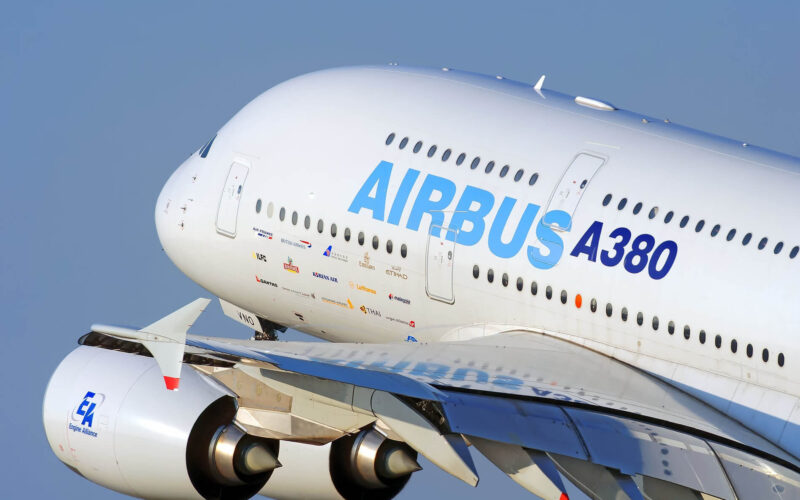As the sun rose over the horizon in March 2020, seemingly, on the other side of the horizon, the sun set behind quad-engine aircraft, leaving them in a dark and unwanted place. Much like the Airbus A340 or the Boeing 747, the Airbus A380 was left there: despite its relatively young program age, the operating costs were too steep. Airlines, apart from a few, retired the double-decker outright or placed them in long-term storage. Much like airlines, the markets have lost their interest in the Airbus A380 too. So, how much value has the aircraft lost?
Undoubtedly, the aircraft’s best days were over even before the current crisis. In February 2019, when Emirates decided to downsize its A380 backlog, Airbus did not have a “substantial A380 backlog and hence no basis to sustain production,” at the time stated the now-retired chief executive Tom Enders.
Emirates still remained its largest customer, though the total number of produced of the Super Jumbo would go down to 251, much lower than Airbus’ expected numbers when it first released the aircraft. Nevertheless, behind the 251 stood companies that had looked at various possible scenarios, including whether there would be a secondary market for the double-decker. The first few Airbus A380s proved that there was little-to-none: Manufacturer Serial Number (MSN) 003 and 005, both owned by Singapore Airlines (SIA1) (SINGY) and leased from Dr. Peters Group, were scrapped. MSN 006, previously operated by the Singaporean carrier (registered 9V-SKC), was the only Airbus A380 that found a secondary home at the Portugal-based ACMI operator, Hi Fly. Currently, it is registered as 9H-MIP, operating under the Hi Fly Malta brand.
Heavy expenditures
Acquiring an aircraft is no doubt a very expensive procedure, especially for such a behemoth as the Airbus A380. According to the manufacturer’s list prices, the double-decker costs $445.6 million. While list prices are only indicative, they still do provide an idea of how much can be spent on one unit. For example, Emirates added six A380s throughout FY2019-20:
“Primary capital expenditure comprising of aircraft spend (including pre-delivery payments, aircraft and engine parts), major aircraft & engine maintenance-related costs and spare engines represented 95% or AED11.3 billion ($3 billion) of the total capital spend,” read the airline’s annual report.
To mitigate some of the capital-extensive costs, airlines lease aircraft instead. The Dubai-based airline is no exception, as it has leased some of its aircraft from lessors as well. For example, four Airbus A380 are leased from a company called Doric Nimrod Air Three, which is based in the United Kingdom. The company was established in 2012 to “deliver an income return and a capital return for its Shareholders by acquiring, leasing and then remarketing aircraft.” The lessor, however, only acquired four aircraft: all Airbus A380s, MSN 132, MSN 133, MSN 134 and MSN 136. All were delivered to Emirates starting August 2013, with MSN 133 being the last aircraft to be delivered on November 27, 2013. And throughout the years, the value of its four aircraft has depreciated. According to Doric Nimrod’s financial statements, the lessor has lost as much as $226.5 million as of March 31, 2020, to accumulated depreciation. However, the estimated residual value has tanked since the current crisis broke out:
Secure position
The company estimated in its FY2014 report that the useful life of its Airbus A380 aircraft is 12 years. In 2013, it entered into a ten-year agreement with Emirates to lease the aircraft, including the option to extend the lease for two additional years. But nevertheless, despite quite a negative outlook for the aircraft in general, the company is fairly secure in its position.
“Should the lessee choose to exit a lease at the end of the initial term of 10 years an early termination payment equal to the present value of the Sterling rent that would have been payable for the extension term of 2 years would be due,” the company stated in its latest financial report. This means that even if Emirates decides to retire the four double-deckers from its fleet in 2023, it would still have to bear the costs of the four until 2025. In addition, the debt will be fully repaid by the time the lease ends, thus Doric Nimrod’s assets would be unencumbered – the remaining residual value would become profit for the lessor.
Despite the current crisis, the company believes in Emirates’ ability to repay its leases.
“The Board notes the continuing market commentary regarding rental deferrals and confirms that it has received no formal request from Emirates to renegotiate their leases and that they are currently servicing them in line with their obligations,” reads its Q3 FY2020 financial report, relevant as of September 30, 2020.

